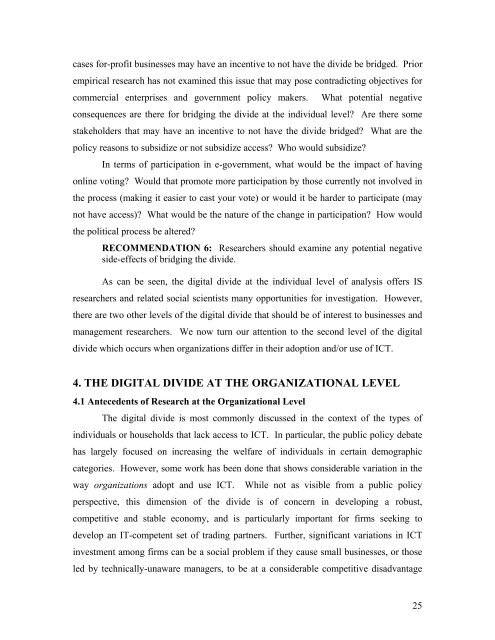The Digital Divide: Current and Future Research Directions - MISRC ...
The Digital Divide: Current and Future Research Directions - MISRC ...
The Digital Divide: Current and Future Research Directions - MISRC ...
Create successful ePaper yourself
Turn your PDF publications into a flip-book with our unique Google optimized e-Paper software.
cases for-profit businesses may have an incentive to not have the divide be bridged. Prior<br />
empirical research has not examined this issue that may pose contradicting objectives for<br />
commercial enterprises <strong>and</strong> government policy makers. What potential negative<br />
consequences are there for bridging the divide at the individual level? Are there some<br />
stakeholders that may have an incentive to not have the divide bridged? What are the<br />
policy reasons to subsidize or not subsidize access? Who would subsidize?<br />
In terms of participation in e-government, what would be the impact of having<br />
online voting? Would that promote more participation by those currently not involved in<br />
the process (making it easier to cast your vote) or would it be harder to participate (may<br />
not have access)? What would be the nature of the change in participation? How would<br />
the political process be altered?<br />
RECOMMENDATION 6: <strong>Research</strong>ers should examine any potential negative<br />
side-effects of bridging the divide.<br />
As can be seen, the digital divide at the individual level of analysis offers IS<br />
researchers <strong>and</strong> related social scientists many opportunities for investigation. However,<br />
there are two other levels of the digital divide that should be of interest to businesses <strong>and</strong><br />
management researchers. We now turn our attention to the second level of the digital<br />
divide which occurs when organizations differ in their adoption <strong>and</strong>/or use of ICT.<br />
4. THE DIGITAL DIVIDE AT THE ORGANIZATIONAL LEVEL<br />
4.1 Antecedents of <strong>Research</strong> at the Organizational Level<br />
<strong>The</strong> digital divide is most commonly discussed in the context of the types of<br />
individuals or households that lack access to ICT. In particular, the public policy debate<br />
has largely focused on increasing the welfare of individuals in certain demographic<br />
categories. However, some work has been done that shows considerable variation in the<br />
way organizations adopt <strong>and</strong> use ICT. While not as visible from a public policy<br />
perspective, this dimension of the divide is of concern in developing a robust,<br />
competitive <strong>and</strong> stable economy, <strong>and</strong> is particularly important for firms seeking to<br />
develop an IT-competent set of trading partners. Further, significant variations in ICT<br />
investment among firms can be a social problem if they cause small businesses, or those<br />
led by technically-unaware managers, to be at a considerable competitive disadvantage<br />
25
















